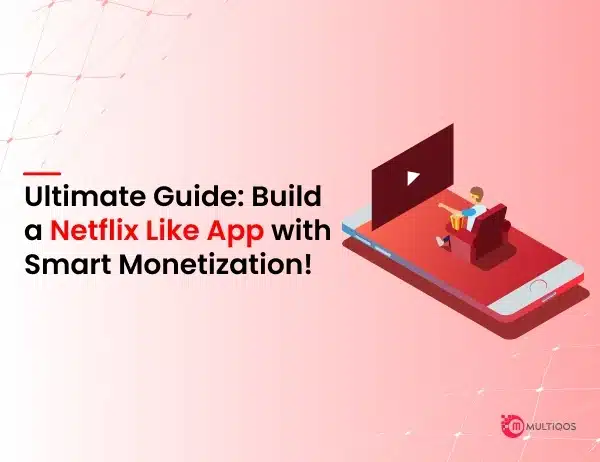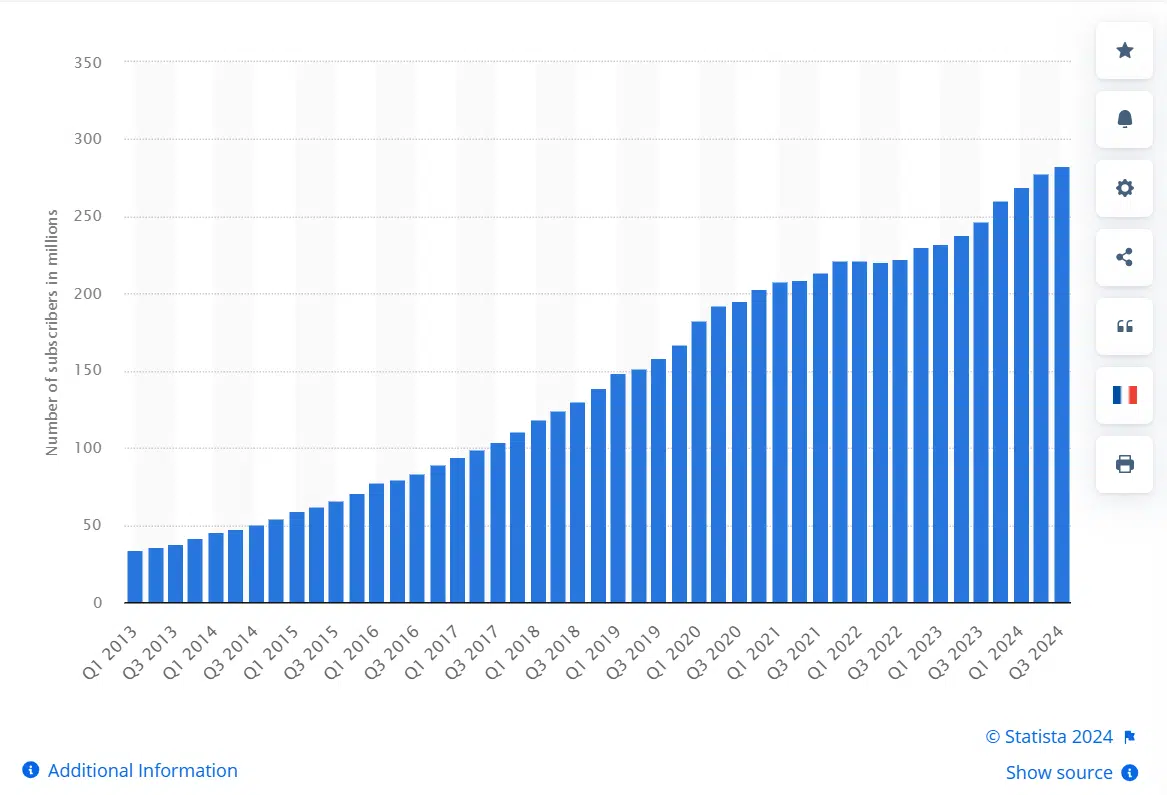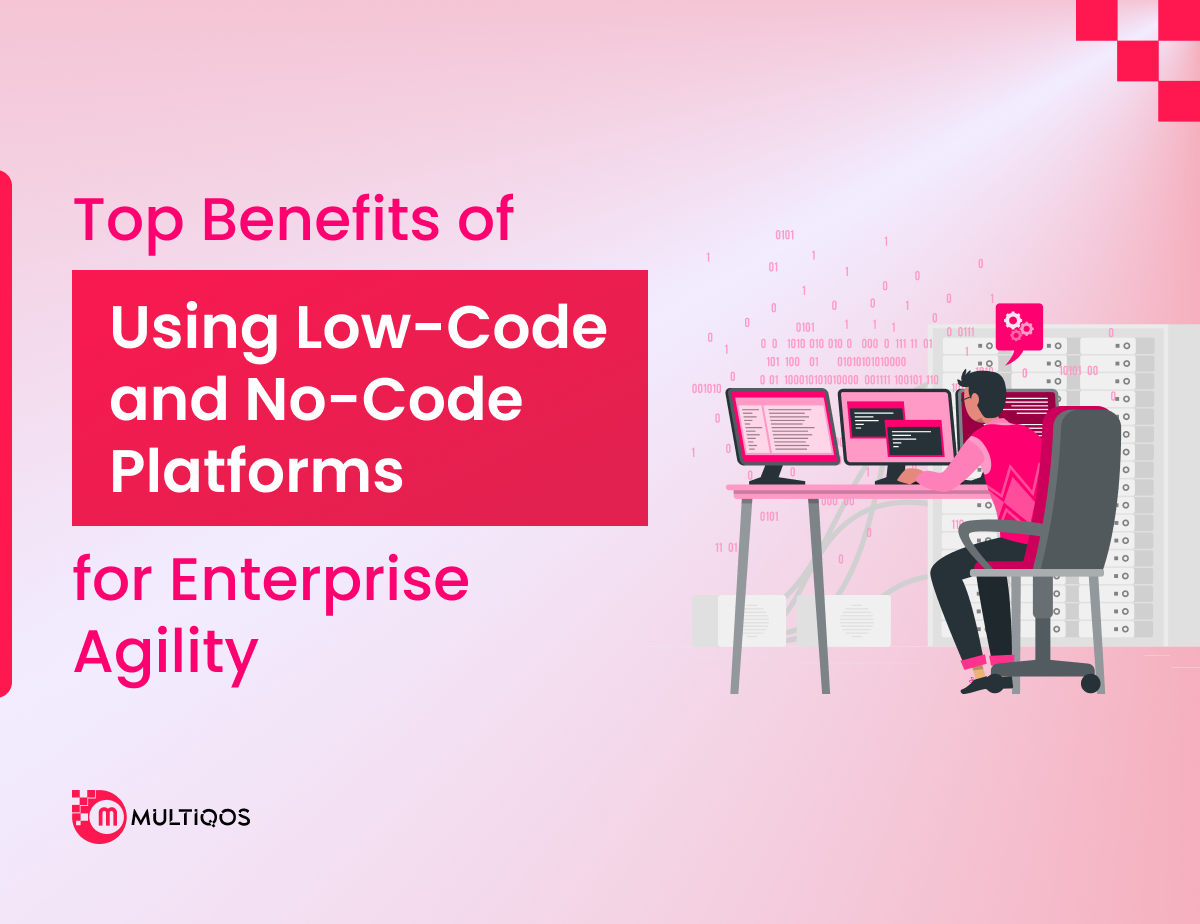How to Develop an App Like Netflix? A Complete Guide with Monetization

Table of Content:
- Introduction
- Benefits of Creating an OTT Platform
- Chapter 1: Market Research and Planning
- Chapter 2: Features and Functionality
- Chapter 3: Technology Stack
- Chapter 4: Design and User Experience
- Chapter 5: Content Management
- Chapter 6: Smart Monetization Strategies
- Chapter 7: Launching Your App
- Chapter 8: Post-Launch Maintenance
- Conclusion
- People Also Ask
Introduction
We all have been in that situation where we find ourselves in front of the TV, remote in hand, hit play and the world is at our fingertips, with few touches on the handphone. The magic of Netflix is undeniable: it is a go-to for movies, series, and documentaries that offer seamless and personalized experiences.
Have you ever wondered what it is like to work behind the scenes? What if you could harness that “Netflix and Chill” experience—the massive content delivery straight to millions of users—into your very own Netflix-like app?
In this post, we’ll see how to create your own streaming app like Netflix. It doesn’t matter whether you’re an IT pro, a programmer, or an ambitious mind with a business idea that revolves around the next innovative mobile app development that will allow people to say, “Let’s Netflix and chill. “

Benefits of Creating an OTT Platform
-
Growing Market
The popularity of on-demand streaming services has grown tremendously in the last few years since more people are cutting television cords and seeking streaming options online.
As internet services become available globally, people are shifting to mobile content consumption, leading to a growing OTT market. This situation indicates that new players are free to enter the market and take a market share.
-
Revenue Potential
The OTT platform development process uncovers several ways of monetization. We have subscription-based models that enable you to generate revenue through services such as streaming video on demand, the advertising-based models known as the advertising video on demand, as well as the transaction-based models known as the transaction video on demand.
For an OTT platform, a global audience can also seek out partnerships, syndications, and differentiation such as premium content to increase revenue making it a very lucrative business.
-
Scalability
OTT platforms also have the advantage of being highly scalable – both in terms of offering and consumers as your platform grows.
In contrast, with cloud infrastructure, the development of new services and the provision of additional functionality can occur with equal ease – the company’s services can grow as necessary, to accommodate the changing base of users.
-
Global Reach
OTT platform also provides a type of broadcasting, which is quite different from the usual geographical broadcasting. Getting content across many regions means that you reach a larger audience and this extends your market frontiers and visibility.
-
Data Insights
OTT platforms generate user behavior data, watching habits and choices making it easier for businesses and investors to make future decisions.
This data enables a firm or company to make relevant decisions in the area of content production, marketing, and customer relations hence enhancing customer loyalty and satisfaction.
Chapter 1: Market Research and Planning
1. Understanding the Market
- Trends and Statistics: Describe modern tendencies in the OTT and streaming market from the point of view of user consumption, content consumption, and technological development. Use statistics to gauge the demand for various content forms like; movies, TV series, documentaries, and events.
- Target Audience Analysis: What aspects of your potential audience you need to understand are their characteristics, actions, and preferences. This is useful for choosing which content to offer to users depending on their age, gender, location, frequency, and time spent on the site.
2. Defining Your Niche
- Identifying Unique Selling Propositions (USPs): Identify the unique selling proposition of your OTT platform. This can be exclusive content, specific types of music/series/genre, different pricing models, or maximized user experience features.
- Competitive Analysis: OTT competitors – A competition analysis of Netflix, Amazon Prime, Disney+, and more, focused on more niche players. Evaluate what they cover, what they do not cover, and how they interact with users to define areas where they have similarities and while they can be different.
Chapter 2: Features and Functionality
1. Essential Features
- User Profiles: Users can create profiles for personalized preferences, experiences, and content tracking.
- Advanced Search: To help users search content based on directors, genres, actors, and more, you can implement a robust search engine with filters.
- Personalized Recommendations: To suggest your users based on their history and preferences, you can use algorithms to suggest content tailored to users.
- Multiple Device Support: Make sure your app is compatible with various devices, such as smartphones, desktops, tablets, smart TVs, etc.
2. Advanced Features
- Offline Viewing: Allow customers to download their content, so they can watch it with ease without using the internet.
- Live Streaming: Provide features for broadcasting live, such as concerts, competitions, news broadcasts, or simply unique live performances.
- Social Sharing: Provide an option, whereby a user can share content or make recommendations on social media sites of their choice from an app.
- Multi-Language Support: Designing content in other languages should be possible to meet the requirements of numerous clients; the use of subtitles and dubbing.
Chapter 3: Technology Stack
1. Frontend Development
Frontend development is essential to make the software easy and pleasant to use for the target consumer. Platforms such as React Native and Flutter are widely being adopted for cross-platform app development as they can be hosted on both Android and iOS providing one codebase solution.
These frameworks offer excellent performance and response from the interface, a plus for OTT platforms.
In web applications, HTML5 and CSS3, together with JavaScript frameworks such as React, Angular, or Vue.js, are crucial in designing an active and aesthetically pleasing web interface. They include seamless media playback and other personalization features for the user.
2. Backend Development
The backend part of the OTT platform ensures that the server, DB, and application logic are properly functioning to deliver content to the users. Some choices like MySQL, PostgreSQL, or NoSQL with MongoDB, and others are used for database management for storing data such as user profiles, content metadata, and history of content views.
AWS, Google Cloud, and Microsoft Azure are the choice providers of backend infrastructure while site traffic scales up.
By implementing a proper server foundation, the viewers will be able to experience uninterrupted flows, faster upload of the materials, and secure work with information.
3. Streaming Protocols
HLS or MPEG-DASH streaming protocols are crucial for delivering videos of high quality to consumers through different devices and connection strength.
These adaptive streaming protocols control the video quality in a way that depends on the available bandwidth for the viewer, thus providing a bust-free video stream.
It is commonly used with live streaming while MPEG –DASH is preferable with on-demand content owing to the flexibility in accommodating all output formats and resolutions. The adoption of these protocols makes it possible for OTT platforms to enhance streaming thus satisfying their users across the globe.
4. Security Measures
Security is a significant factor while developing an OTT platform to avoid leakage of customer data and provide a safe environment for their interactions. Some algorithms used in the encryption of the user data when in transmission include HTTPS, and SSL/TLS to protect the identity of users’ data.
Also, integrating secured payment gateways such as Stripe, PayPal, or Razorpay payment gateway for the appropriate subscription and payment handling is mandatory. They also support standard regulatory compliance such as PCI-DSS to guarantee safe methods of operations when dealing with users’ finances.
When the stakeholders implement sturdy security approaches, then the OTT platforms shall ensure the confidence and security of the users and content.
Chapter 4: Design and User Experience
1. UI/UX Best Practices
UI design plays a crucial role in creating an OTT platform easy-to-navigate and visually appealing. Easy site navigation is one way to ensure that the user can quickly locate the content and have fun viewing it.
Moreover, every detail of the platform’s design relies on easy-to-use menus, clearly defined sections, and search options.
Responsiveness is also a key factor because the platform should look good on screens of all sizes – from smartphones to smart TVs. Compliance with different gadgets provides people with definite, qualitatively pleasant experiences that, in turn, contribute to high rates of website visits and enhanced retention.
2. Prototyping and Testing
It is equally important to prototype and perform several tests in the designing of an optimal OTT platform. Prototyping tools such as Sketch, Figma, or Adobe XD help a designer create colorful wireframes and simple prototypes, which demonstrate the flow and interaction of the future app before it is developed. This leads to creating a good picture of a user journey and thus uncovering other design flaws at the appropriate time.
Design checks are also equally crucial to confirm the usability of the design to the users. It helps market designers to exercise the prepared prototypes on real customers to determine how easy it is to use the platform and the main barriers to the smoothed interface.
Testing is often performed and results are evaluated many times to deliver the final product that corresponds to the users’ needs and increases engagement.
Chapter 5: Content Management
1. Content Acquisition
Obtaining high-quality content is important in any OTT platform. Due to licensing agreements that the platform has with content creators, studios, or producers the website can legally show movies, TV shows, documentaries, and other such content. These issues include the time frame within which the agreement will be implemented, the cost of the services, and the location.
Creating original content is another important aspect of content acquisition. To create unique and exclusive content, an OTT platform can make itself stand out from the competitors, build brand identity, and attract subscribers who are interested in watching unique content that isn’t available elsewhere.
2. Content Delivery Network (CDN)
The main component that helps in the fast distribution of the content is a Content Delivery Network (CDN). It relies on a network of servers that store content to deliver it closer to the user and makes streaming high-quality.
The role of a CDN cannot be overlooked as it ensures uninterrupted, high-quality video playback regardless of the traffic load.
Choosing the right CDN service provider is important to get scalability, reliability, and dependable security. Preeminent CDN solutions suppliers such as Akamai, Cloudflare, AWS CloudFront, etc., provide various CDN services to deliver content to any part of the world with high speed, security, and reliability for end-users.
Chapter 6: Smart Monetization Strategies
1. Subscription Models
The most popular and effective methods of monetization for OTT platforms are based on subscriptions.
The Freemium model allows the availability of basic content for free and prohibits chargeable or paid ones or additional content. This strategy assists in acquiring new consumers by easing the channel entry and at the same time enticing them to advance to better levels.
The Premium model on the other hand has a monthly/ yearly subscription for customers to be able to access all content on the website. Self-generated content typically means ad-free viewing, priority access to new content, and/or other benefits of subscribing that protect the company’s revenue expectations.
2. Ad-Supported Model
This is achieved by offering free access to content through an ad-supported model which makes the businesses earn revenue through advertisements. Some of the common classified ads include; Display ads, Video ads, and Banner ads; all these bear a different feel and taste as well as revenue return.
Digital video advertising including pre-roll, mid-roll, and post-roll advertisements is perfect for the OTT platform as it interrupts users during content consumption.
To get ads out to viewers while watching a video and without interrupting the users viewing pleasure, implement ad placement strategies that determine the right moments to show ads without negatively impacting viewer satisfaction.
3. Pay-Per-View
This is a billing model where the users are charged per piece of content they want to access such as a movie or series which doesn’t include full access to a service. This model is best suited for certain content, for example, live streaming of events the newest sports matches, or movies where users willingly pay to watch the content.
Also, this model is suitable when you’re targeting niche audiences or providing one-time events.
Pricing procedures for PPV should reflect factors like content competition, exclusivity, and demand, allowing for flexible pricing models based on the quality of content for multiple PPV events.
Chapter 7: Launching Your App
1. Final Testing
There are a few things that need to be kept in mind before deploying the app such as testing the OTT app. Beta testing checks for any glitches before reaching the general public it is launched to a sample community to help identify issues with operation, interface, and performance.
This phase enables one to note forth bugs, further enhance some functionalities, and possibly confirm the customer’s expectation.
Also, load testing is an important aspect of evaluating the app’s ability, particularly when a large number of users access the content at a time. When optimizing an app, load testing assures that it supports projected user traffic and runs smoothly during aggressive usage.
2. App Store Submission
After testing or during the testing process, you’re all set to launch your app on the app stores. When developing iOS or Android apps, there are some standard rules and requirements that need to be followed.
First, the user interface must be perfect, second, there must be perfect descriptions of the app, and lastly, mention of the privacy policy and terms to use regarding the app.
Approval tips include the fact that the app must work without issues, have no bugs, and offer value to its users. Submissions of detailed and clear app descriptions, high-quality screenshots, and short videos of the app in action can boost the chances of approval.
Also, it’s great to check your app against the privacy and security regulations to avoid situations when it will be reviewed and rejected or the app will face a long queue in the review process.
Chapter 8: Post-Launch Maintenance
1. Monitoring Performance
When your OTT app is ready and deployed, constant tracking of how it performs is crucial to verify that the app runs efficiently and users enjoy a positive user experience.
The success of an app depends on many factors and thus a performance tracking tool like Google Analytics, Firebase, or Mixpanel enables you to track users’ behavior, engagement, and performance statistics so that you can recognize trends and make a data-driven decision.
Also, users’ feedback is important because it is used to determine satisfaction levels and areas of concern. A call for comments and feedback from users can be a way of getting insights on what should remain as it is, improved, fixed, or added.
2. Regular Updates
To ensure the app’s continued ability to run and engage its users, performing regular updates is important. Bug fixes are a top priority as there is always a need to address problems that make the product slow or difficult to navigate, which will drive users away.
New features should also be introduced at some intervals to increase the excitement of the users. When the usage and feedback data are available, it is possible to add features that would contribute to the overall experience, search, content recommendation, and maybe even new types of content.
The daily update is crucial to maintaining the app’s relevancy and making it befitting the dynamic users’ needs and expectations.
Conclusion
After reading this post, we know that the demand for OTT platforms continues to grow, and staying ahead of technological advancements is essential to maintain a competitive edge.
AI and ML are an active driving force when it comes to personalizing customer experiences in content curation and process enhancement. Businesses can use these technologies to identify enormous user data and predict which type of content will engage the audiences which can lead to higher retention rates.
Furthermore, AR and VR are expected to completely redefine how users interact with content providing the necessary consumer immersion necessary to improve entertainment and user interactivity. For any leading application development company, it is crucial to use these innovative solutions to create groundbreaking experiences and keep the OTT platform on the leading edge of the business.
Thus, by adopting these future trends, OTT platforms will only evolve and provide audiences with more opportunities to engage with their favorite content.
People Also Ask
There are the Freemium and Premium business models for subscriptions, an ad-supported model, and the pay-per-view (PPV) model for paid content.
Use a secure sockets layer (SSL/TLS), secure payment gateways, strong user authentication, and security checks on the site regularly.
You can perform load testing, beta testing, and usability testing before launching your OTT app to ensure that it functions well and meets user expectations.
Future trends are AI and machine learning for individualization, virtual reality/augmented reality for; interactive content; and 5G for faster streaming.
To get started, you just need to fill out the Contact Us form or send us an email at biz@multiqos.com. Our team will schedule an appointment to discuss your ideas about your project, aims, and objectives. We’ll help you transform an idea into an incredibly successful app for streaming and delivering fantastic content!
Get In Touch










